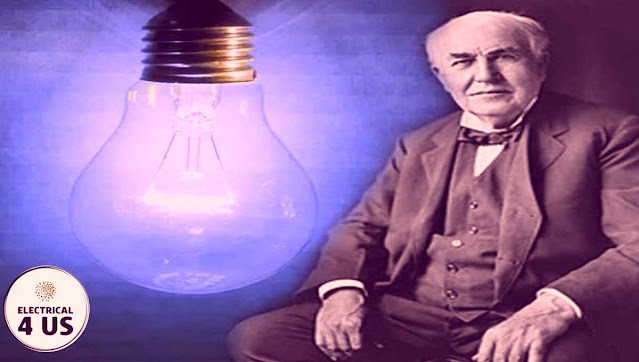Calculator
- Home
- Transformers
- _What is Transformers?
- _Top 10 Transformers In India
- Electrical genrating Plants
- _Hydro Power Plant
- _Biomass Power Plant
- _CHP Plant
- _Fossil Fuel Plant
- _Thermal Power Plant
- _Solar Power Plant
- Generator
- _Top 10 generator
- _Genrator Price
- _DC Generator
- Invention & Laws
- _Light Bulb Invention
- _Faraday's Law of Induction
- _Faraday's Law of Electrolysis
- _Fleming Right hand rule
- _Joule's Law of Heating
- _Ohm's Law of Conduter
- _Lenz's Law of electromagnet
Who discovered electric bulb first?
Who discovered electric bulb first?
Thomas Edison is usually credited with the invention of the light bulb, but the famous American inventor was not the only one who contributed to the development of this revolutionary technology. Many notable figures are also remembered for the creation of electric batteries, lamps and the first incandescent bulbs.
The story of the light bulb begins long before Edison patented the first commercially successful bulb in 1879. In 1800, Italian inventor Alessandro Volta developed the voltaic pile, the first practical method of generating electricity. The glowing copper wire of the Volta is also believed to be one of the earliest manifestations of incandescent lighting.
Shortly after Volta presented his discovery of a constant source of electricity to the Royal Society in London, an English inventor named Humphry Davy designed the world's first electric lamp by connecting voltaic piles to charcoal electrodes. Davy's 1802 invention was known as the electric arc lamp.
While Dewey's arc lamp was certainly an improvement over Volta's stand-alone piles, it still wasn't a very practical source of light. This rudimentary lamp burned out quickly and was too bright for use in the home or work space. But the principles behind Dewey's arc light were used in the development of many other electric lamps and bulbs throughout the 1800s.
It was the year 1840 when British scientist Warren de la Rue developed an expertly designed light bulb using a coiled platinum filament in place of copper, but the high cost of platinum prevented the bulb from becoming a commercial success. And in 1848, Englishman William Staat improved on the longevity of traditional arc lamps by developing a clock
work mechanism that controlled the movement of the lamp's quick-to-decay carbon rod. But the cost of the batteries used to power the stat's lamps hurt the inventor's business ventures.
The first practical incandescent light bulb
Now, about the glass of the bulb. The glass is developed by the same company that develops Gorilla Glass nowadays. Yes, the name of the company is Corning.
Most Popular
Categories
- 10 kVA Stabilizer (1)
- Alternator (3)
- Ampear (1)
- Armature (1)
- Battery (1)
- Biogas (1)
- Biomass (1)
- Boiler (1)
- Bulb Thomas Alva Edison (1)
- Capacitors (1)
- Cogeneration (2)
- Conductor (1)
- Contractor (1)
- Crankshaft (1)
- DC Generator (1)
- Diesel Generator (2)
- Diodes (1)
- Earthing (1)
- Electric Meter (1)
- ElectricIan Tools (1)
- Electricity generation (1)
- Electricity Saving Tips (1)
- Electrolysis (1)
- Electromotive force (1)
- Electron (1)
- EMF (1)
- Faraday's law (2)
- Fleming rules (1)
- Fossil Fuel (1)
- Fuse (1)
- Generator (2)
- Heater (1)
- Hydropower (1)
- Ic (1)
- Incandescent Bulb's Law (1)
- Inverter (1)
- Joule's Law of Heating (1)
- Kirchoff current law (1)
- Kirchoff Voltage Law (1)
- Kirloskar Generator (1)
- Lenz law (1)
- Lighting Arrester (1)
- Magnetic Field (1)
- MCB (2)
- Motor (1)
- Multimeter AC and DC Measuring tools (1)
- Nuclear Power plant (1)
- Ohm's Law (1)
- Power Factor (1)
- RCB (1)
- RCBO (1)
- RCCB (1)
- Rectifier (1)
- Relay (1)
- Resistor (1)
- Resistor in series Resistor in parallel Resistor formula Resistor calculator Resistor problem (1)
- Servo Stabilizer (1)
- Short circuit Circuit breaker (1)
- Solar Energy (1)
- Star delta (1)
- Thermal Power (1)
- Tidal waves Power (1)
- TOP 10 Cable (1)
- Transformer (2)
- Turbine (1)
- Windmill (1)
Popular Post
Labels
- 10 kVA Stabilizer
- Alternator
- Ampear
- Armature
- Battery
- Biogas
- Biomass
- Boiler
- Bulb Thomas Alva Edison
- Capacitors
- Cogeneration
- Conductor
- Contractor
- Crankshaft
- DC Generator
- Diesel Generator
- Diodes
- Earthing
- Electric Meter
- ElectricIan Tools
- Electricity generation
- Electricity Saving Tips
- Electrolysis
- Electromotive force
- Electron
- EMF
- Faraday's law
- Fleming rules
- Fossil Fuel
- Fuse
- Generator
- Heater
- Hydropower
- Ic
- Incandescent Bulb's Law
- Inverter
- Joule's Law of Heating
- Kirchoff current law
- Kirchoff Voltage Law
- Kirloskar Generator
- Lenz law
- Lighting Arrester
- Magnetic Field
- MCB
- Motor
- Multimeter AC and DC Measuring tools
- Nuclear Power plant
- Ohm's Law
- Power Factor
- RCB
- RCBO
- RCCB
- Rectifier
- Relay
- Resistor
- Resistor in series Resistor in parallel Resistor formula Resistor calculator Resistor problem
- Servo Stabilizer
- Short circuit Circuit breaker
- Solar Energy
- Star delta
- Thermal Power
- Tidal waves Power
- TOP 10 Cable
- Transformer
- Turbine
- Windmill






0 Comments